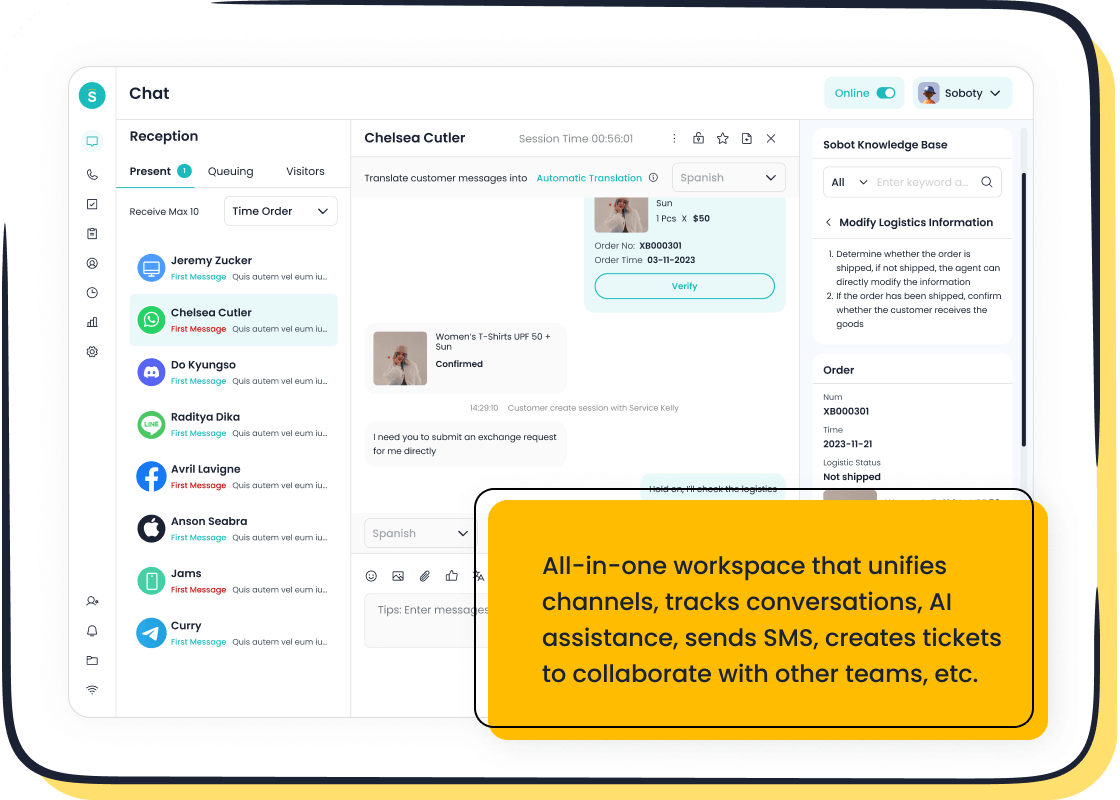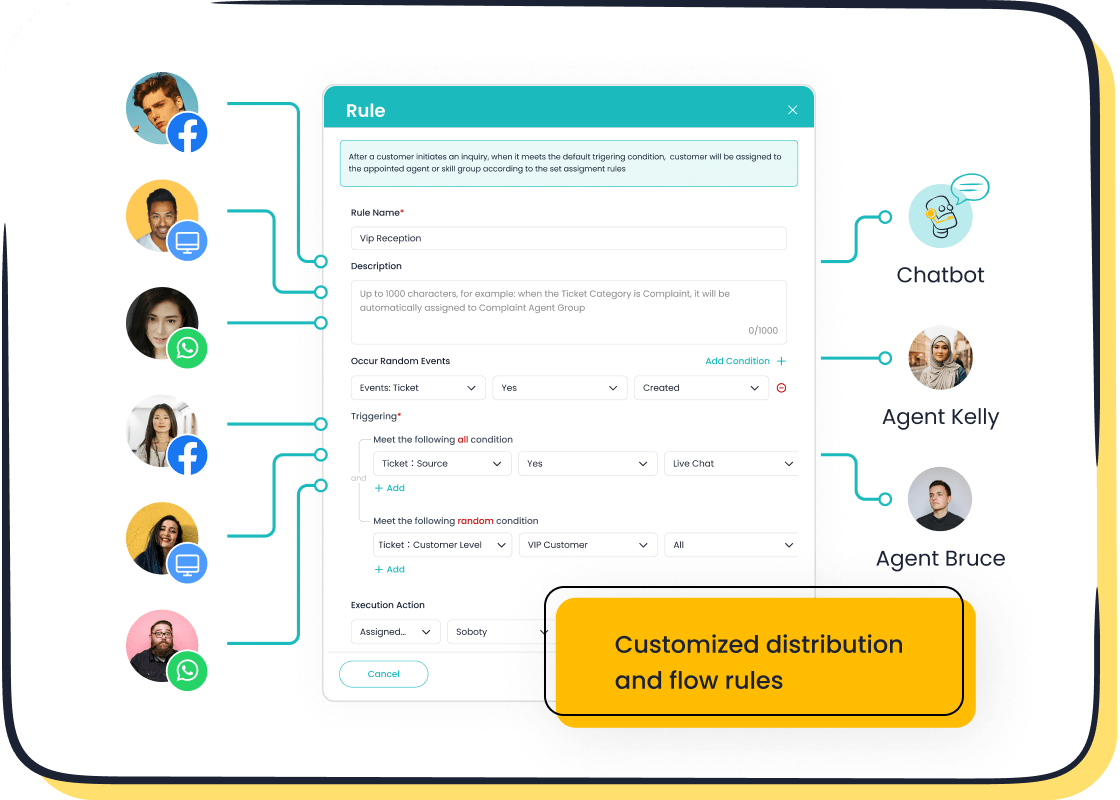Steps to Craft a Sincere Apology Email for Customers

Mistakes happen, but how you address them makes all the difference. A sincere apology email can rebuild trust and show your customers you genuinely care. Studies reveal that 45% of customers retract negative reviews after receiving an apology, proving how impactful they can be. A well-crafted business apology email demonstrates accountability, strengthens relationships, and even turns unhappy customers into loyal advocates. It’s not just about saying sorry—it’s about showing you’re committed to making things right. Sobot understands this, and their tools can help you deliver apologies that resonate. Need an example of an apology email to a customer? Let’s explore how to get it right.
Why a Sincere Apology Email Matters in Customer Service

Building Trust Through Empathy
When you show empathy in your apology email, you’re not just saying sorry—you’re showing your clients that you truly understand their frustration. Empathy helps nurture trust and makes customers feel valued. For example, leaders like Satya Nadella at Microsoft and Howard Schultz at Starbucks have demonstrated how empathy can transform relationships. By addressing customer concerns with care, they’ve built stronger connections and improved satisfaction.
A sincere apology email that acknowledges the customer’s feelings can turn a negative experience into a positive one. It’s not just about fixing the issue; it’s about showing you care. This approach helps build relationships and encourages loyalty, even after mistakes.
Strengthening Customer Relationships After Mistakes
Mistakes happen, but how you handle them can define your relationship with your clients. Acknowledging errors shows integrity and a commitment to making things right. For instance, when companies recall products, they often thank customers for their patience and offer discounts. This not only resolves the issue but also strengthens the bond with their audience.
Taking responsibility in your apology email demonstrates that you value honesty. It’s a chance to rebuild trust and show your clients that their satisfaction matters. Over time, this approach can deepen relationships and foster loyalty.
The Role of Timely Communication in Customer Satisfaction
Timing is everything in customer service. Nearly half of customers expect email responses within four hours, and 77% say quick replies are key to their satisfaction. A prompt apology email shows that you prioritize their concerns and are committed to resolving issues quickly.
Fast responses also enhance your brand’s reputation. Customers are more likely to trust and engage with businesses that act swiftly. By addressing problems promptly, you not only improve satisfaction but also encourage repeat business. Quick communication is a simple yet powerful way to nurture trust and build lasting relationships.
Key Components of an Effective Apology Email
Acknowledging the Mistake Clearly
When you own the mistake, you show your customers that you’re willing to take accountability. A clear acknowledgment of the issue is the first step in crafting a professional apology. Avoid vague language or deflecting blame. Instead, be specific about what went wrong. For example, if an order was delayed, say, “We regret that your order didn’t arrive on time due to an unexpected shipping error.”
Acknowledging the mistake builds trust and demonstrates sincerity. Research shows that customers are 32% more likely to forgive a service mistake when offered a heartfelt apology rather than financial compensation. By addressing the issue head-on, you set the stage for repairing the relationship and moving forward.
Expressing Genuine Regret
Sincerity matters. When you express regret, it’s not just about saying “sorry.” It’s about showing empathy and understanding the impact of the mistake on your customers. Use language that conveys genuine remorse, such as “We deeply regret the inconvenience this has caused you.”
A professional apology should also include a commitment to do better. This shows that you’re not only sorry but also determined to prevent similar issues in the future. Customers appreciate honesty and sincerity, and this approach helps rebuild trust while strengthening the relationship.
Offering Solutions and Next Steps
An apology email isn’t complete without offering solutions. Customers want to know how you plan to fix the problem and ensure it doesn’t happen again. For example, if a product was defective, you could offer a replacement or refund. If the issue was a service delay, explain the steps you’re taking to improve efficiency.
Providing concrete solutions demonstrates accountability and a genuine desire to make things right. It’s also an opportunity to reassure your customers that you value their satisfaction. Commit to not repeating the harm and outline the next steps clearly. This approach not only resolves the immediate issue but also fosters long-term loyalty.
Maintaining a Professional and Positive Tone
The tone of your apology email can make or break its effectiveness. A friendly and empathetic tone helps transform a negative experience into a positive one. Avoid overly formal or robotic language. Instead, write as if you’re speaking directly to the customer.
For example, instead of saying, “We apologize for the inconvenience,” try, “We’re truly sorry for the trouble this has caused you.” Research shows that an upbeat tone increases customer engagement and satisfaction. By maintaining professionalism while showing empathy, you can humanize your brand and leave a lasting positive impression.
Closing with Gratitude and Reassurance
End your apology email on a positive note. Thank your customers for their patience and understanding. Reassure them that their concerns are being addressed and that you’re committed to improving. For instance, you could say, “Thank you for giving us the chance to make this right. We value your trust and look forward to serving you better in the future.”
This closing reinforces your sincerity and leaves the customer with a sense of resolution. Gratitude and reassurance go a long way in repairing the relationship and encouraging continued loyalty.
Step-by-Step Guide to Writing a Sincere Apology Email

Step 1: Crafting a Clear and Relevant Subject Line
The subject line is the first thing your customers see, so it needs to grab their attention while setting the right tone. A clear and relevant subject line can significantly increase email open rates. Think of it as your chance to show sincerity and urgency.
Here’s a quick tip: Use emotional or intriguing language to connect with your audience. For example, subject lines like “Make It Right: You Deserve Better” or “Oops! My bad... Let me make it up to you!” evoke curiosity and empathy. Studies show that subject lines with emotional appeal or humor are more likely to engage recipients.
| Subject Line | Type | Reason for Effectiveness |
|---|---|---|
| Make It Right: You Deserve Better, Forgive Me | Emotional | Evokes personal accountability and empathy, creating a compelling connection. |
| Oopsie-daisy! Can you forgive me? | Funny | Uses a playful tone to grab attention and evoke curiosity. |
| Apology Alert: Urgent Action Needed - I'm Truly Sorry | Emotional | Creates urgency and intrigue, compelling recipients to engage. |
When writing an apology email, your subject line should reflect your commitment to making things right. Keep it short, sincere, and relevant to the issue at hand.
Step 2: Addressing the Customer Personally
Personalization is key to sincerity. Addressing your customers by name shows that you value them as individuals, not just as numbers in your database. It’s a simple yet powerful way to make your apology feel genuine.
For example, instead of starting with “Dear Customer,” use their name: “Dear Sarah, we’re truly sorry for the inconvenience caused.” This small touch can make a big difference in how your apology email is received.
Personalizing apology emails enhances sincerity and builds trust. It shows transparency, acknowledges the impact of mistakes, and assures customers of corrective actions.
By addressing your customers personally, you create a connection that fosters confidence and strengthens relationships.
Step 3: Taking Responsibility for the Issue
Taking responsibility is the cornerstone of a sincere apology. Avoid shifting blame or making excuses. Instead, own up to the mistake and show your customers that you’re committed to fixing it.
For instance, if a product was defective, say: “We take full responsibility for the inconvenience caused by the faulty product. This was entirely our oversight, and we’re working to ensure it doesn’t happen again.”
Here are some key points to keep in mind:
- Don’t minimize the issue. Acknowledge its seriousness.
- Use direct apology language, like “We’re sorry for the trouble this caused you.”
- Avoid phrases like “I’m sorry you feel that way,” which can sound insincere.
Taking responsibility shows integrity and builds trust. It’s a vital step in writing an apology email that resonates with your audience.
Step 4: Apologizing Sincerely and Specifically
A generic apology won’t cut it. Customers want to know that you understand their specific issue and regret the impact it had on them. Be detailed and heartfelt in your apology.
For example, instead of saying “We’re sorry for the inconvenience,” try: “We’re deeply sorry for the delay in delivering your order. We understand how frustrating it must have been to wait longer than expected.”
Did you know that 73% of customers abandon a brand after three negative experiences? A sincere apology can help reduce churn and improve retention rates.
By apologizing sincerely and specifically, you show your customers that you care about their experience and are committed to making things right.
Step 5: Providing a Solution or Compensation
An apology email isn’t complete without a clear plan of action. Customers want to know how you’ll fix the problem and prevent it from happening again. Offering a solution or compensation demonstrates accountability and reassures them of your commitment.
For example, if a service outage disrupted your customer’s business, you could say: “We’re working to ensure this doesn’t happen again. As a token of our apology, we’re offering you a 20% discount on your next purchase.”
Here’s why this matters:
- Proactive communication shows you’re addressing their concerns.
- Following up after resolving the issue fosters trust.
- Personal oversight of the resolution process reassures customers of their importance.
Providing a clear plan of action not only resolves the immediate issue but also strengthens your relationship with your customers.
Step 6: Reassuring the Customer and Thanking Them
Reassurance is the final touch that leaves your customers feeling valued. Let them know you’re taking steps to improve and thank them for their patience.
For example, you could say: “Thank you for giving us the opportunity to make this right. We’re committed to improving our processes to serve you better in the future.”
This closing reinforces your sincerity and shows gratitude. It’s a simple yet effective way to end your apology email on a positive note.
Step 7: Proofreading and Sending Promptly
Before hitting send, take a moment to proofread your email. Typos or unclear language can undermine your sincerity. Make sure your message is clear, professional, and free of errors.
Timing is also crucial. Customers appreciate prompt communication, especially when addressing issues. Sending your apology email quickly shows that you prioritize their concerns and are committed to resolving them.
By proofreading and sending promptly, you ensure your apology email is both effective and well-received.
Common Mistakes to Avoid in Apology Emails
Using Generic or Automated Responses
Nobody likes receiving a robotic message that feels impersonal. When your apology email sounds like it was copied and pasted, it can make customers feel unimportant. Instead of using generic templates, take the time to personalize your message. Address the customer by name, mention the specific issue, and show genuine regret.
For example, instead of saying, "We apologize for the inconvenience," try something like, "Hi Sarah, we’re truly sorry for the delay in delivering your order. We understand how frustrating this must have been for you." A little effort goes a long way in making your apology feel sincere and human.
Tip: Use tools like Sobot Live Chat to personalize your communication. It helps you keep track of customer interactions and tailor your responses effectively.
Avoiding Responsibility or Blaming the Customer
Shifting blame or avoiding responsibility can backfire. Customers expect you to own up to mistakes, not point fingers. Saying things like, "We’re sorry you misunderstood our instructions," can come across as dismissive and insincere.
Here’s why taking responsibility matters:
- Effective recovery strategies, like offering compensation, can reduce negative attitudes.
- Inaction or inadequate responses can worsen dissatisfaction.
- Customers blame companies more when they perceive the issue as severe or mishandled.
Instead, say something like, "We take full responsibility for the inconvenience caused by the delay. This was our oversight, and we’re working to ensure it doesn’t happen again." Owning up builds trust and shows integrity.
Overloading the Email with Technical Jargon
Using overly technical language can confuse your customers and dilute the sincerity of your apology. Keep your message simple and clear. Avoid phrases like, "Due to a server-side latency issue, your request was queued for asynchronous processing." Instead, say, "We experienced a technical issue that delayed your request, and we’re sorry for the inconvenience this caused."
Your goal is to make the apology easy to understand. A clear explanation reassures customers that you’re addressing the problem without overwhelming them with unnecessary details.
Failing to Offer a Resolution
An apology without a solution feels incomplete. Customers want to know how you’ll fix the issue and prevent it from happening again. If you don’t offer a resolution, your apology email might leave them feeling frustrated.
For instance, if a product was defective, you could say, "We’re sending you a replacement at no additional cost. It should arrive within three business days." Providing a clear plan of action shows that you’re committed to making things right.
Note: Always follow up after resolving the issue. It reinforces your dedication to excellent service and leaves a lasting positive impression.
Delaying the Apology
Timing is everything. Waiting too long to send an apology email can make the situation worse. Customers may feel ignored or undervalued if you take too long to address their concerns.
Send your apology as soon as you’re aware of the issue. A prompt response shows that you prioritize their satisfaction and are actively working to resolve the problem. Quick communication can turn a negative experience into a positive one, strengthening your relationship with the customer.
Examples of Well-Crafted Apology Emails for Customers
Example of an Apology Email to a Customer for a Delayed Order
Delays can frustrate customers, but a thoughtful apology email can turn things around. Here’s how you can craft one:
- Basic Professional Apology: “We’re sorry for the delay in processing your order. Due to unforeseen circumstances, it took longer than expected. As a token of our apology, we’ve applied a 10% discount to your next purchase.”
- Technical Issue Explanation: “We experienced a technical glitch that caused the delay. Your order is now on its way, and we’ve added free premium support to ensure a smooth experience.”
- Staff Illness Situation: “We regret the delay caused by unexpected staff shortages. Your order has been carefully prepared and shipped. To make up for the inconvenience, we’ve included a bonus service.”
- High Volume Period: “Due to high demand, your order was delayed. We’ve expedited shipping and applied a special discount to thank you for your patience.”
- Missing Information Resolution: “The delay occurred because we needed additional details to complete your order. It’s now on its way, and we’re offering free delivery and installation as an apology.”
These examples show how to acknowledge the issue, explain the cause, and offer a resolution. A clear and empathetic tone reassures customers and strengthens trust.
Example of an Apology Email to a Customer for a Billing Error
Billing errors can damage trust, but a sincere apology email can repair the relationship. Here’s an example:
“Dear [Customer Name],
We’re truly sorry for the billing error on your recent purchase. After reviewing your account, we found that you were overcharged by $15. We’ve already refunded the amount to your original payment method.
To prevent this from happening again, we’ve updated our billing system and added extra checks. As a gesture of goodwill, we’ve also credited $10 to your account for your next purchase.
Thank you for bringing this to our attention. We value your trust and are committed to providing better service in the future.
Sincerely,
[Your Name]”
This email takes responsibility, explains the error, and provides a resolution. It also reassures the customer that steps are being taken to avoid future mistakes.
Example of an Apology Email to a Customer for Poor Service
When service falls short, a heartfelt apology email can make a big difference. Here’s an example:
“Dear [Customer Name],
We’re deeply sorry for the poor service you experienced during your recent interaction with us. We understand how frustrating it must have been to wait for assistance, and we take full responsibility for not meeting your expectations.
To address this, we’ve provided additional training to our team to ensure better service moving forward. As an apology, we’ve added a $20 credit to your account, which you can use on your next purchase.
Thank you for your patience and understanding. We’re committed to improving and hope to serve you better in the future.
Sincerely,
[Your Name]”
This email acknowledges the issue, expresses regret, and outlines steps to improve. It also includes compensation to show the customer they’re valued.
Example of an Apology Email to a Customer for a Technical Issue
Technical issues can disrupt the customer experience, but a well-crafted apology email can restore confidence. Here’s an example:
“Dear [Customer Name],
We’re sorry for the technical issue that affected your recent experience with our platform. We understand how inconvenient this must have been. The issue occurred due to a server error, which has now been resolved.
Here’s what we’ve done to make things right:
- Your account has been credited with one month of free premium access.
- Our team has implemented additional safeguards to prevent similar issues in the future.
Thank you for your patience as we worked to resolve this. If you have any further concerns, please don’t hesitate to reach out. We’re here to help.
Sincerely,
[Your Name]”
This email uses best practices like personalization, clarity, and actionable steps. It reassures the customer and invites feedback to ensure satisfaction.
Tip: When handling technical issues, follow these principles:
- Personalize the email to make the customer feel valued.
- Clearly explain the issue and the steps taken to resolve it.
- Offer compensation or a goodwill gesture to rebuild trust.

How Sobot Live Chat Can Help Streamline Apology Emails
Leveraging AI-Assisted Tools for Personalization
Personalization is the heart of a sincere apology email. Customers want to feel valued, not like just another number. Sobot Live Chat makes this easy with its AI-assisted tools. These tools analyze customer interactions and preferences, helping you craft tailored messages that resonate. For instance, if a customer faced a delayed order, the system can pull up their purchase history and suggest a personalized apology addressing the specific issue.
AI also ensures consistency in tone and language, making your emails sound empathetic and professional. By using Sobot Live Chat, you can create apology emails that feel genuine and human, even when automated. This level of personalization not only rebuilds trust but also strengthens customer loyalty.
Using Built-In Analytics to Identify Common Issues
Understanding why mistakes happen is key to preventing them. Sobot Live Chat’s built-in analytics provide valuable insights into customer interactions. These analytics help you spot recurring issues, like delayed responses or technical glitches, so you can address them proactively.
For example, real-time analytics can reveal patterns in customer complaints, enabling quicker resolutions. According to a report on contact center analytics, organizations using such tools make better decisions and improve customer satisfaction. With Sobot Live Chat, you can turn data into actionable insights, ensuring your apology emails address the root cause of problems.
| Source | Evidence |
|---|---|
| Call Center Analytics to Know to Improve the Customer Experience [2023] | Organizations can make better-informed decisions about their strategies and operations through analytics. |
| Real-Time Analytics for Contact Centers | Enables quicker resolutions and personalized interactions, significantly enhancing the customer experience. |
Enhancing Customer Communication Across Channels
Customers interact with businesses through various platforms, from social media to email. Managing these channels can be overwhelming, especially when addressing issues. Sobot Live Chat simplifies this by unifying all communication channels into one platform. Whether a customer reaches out via WhatsApp, Facebook, or your website, you can respond seamlessly.
This omnichannel approach ensures no message slips through the cracks. A leading e-commerce company, for example, reduced response times from 15 minutes to just 2 minutes using automation tools. With Sobot Live Chat, you can enhance communication efficiency, making it easier to send timely and effective apology emails.
Automating Follow-Ups to Reinforce Customer Trust
A single apology email might not always be enough. Follow-ups show customers that you’re genuinely committed to resolving their concerns. Sobot Live Chat automates this process, sending timely updates and reassurances. For instance, if a customer’s issue requires multiple steps to resolve, the system can schedule follow-up emails to keep them informed.
Automation also frees up your team to focus on complex tasks. A financial services firm improved efficiency by 40% using automation, allowing agents to handle more critical issues. With Sobot Live Chat, you can maintain consistent communication, reinforcing trust and ensuring customer satisfaction.
Crafting a sincere apology email boils down to a few essential steps: acknowledge the mistake, express regret, offer solutions, and reassure your customers. These actions show empathy, take responsibility, and prioritize timely communication, which are proven to improve customer experiences.
- Empathy builds trust by showing you care about their frustrations.
- Responsibility demonstrates integrity and strengthens relationships.
- Timely communication alleviates concerns and fosters satisfaction.
Tools like Sobot Live Chat simplify this process. AI-assisted features personalize messages, automate follow-ups, and streamline workflows. For example, AI chatbots can instantly address common issues, trigger discounts, or escalate concerns, ensuring quick resolutions. This combination of technology and human touch enhances customer satisfaction by up to 62%.
By combining empathy, responsibility, and timely communication with advanced tools, you can turn mistakes into opportunities to build lasting trust.
FAQ
How soon should you send an apology email after a mistake?
You should send it as soon as possible—ideally within 24 hours. Quick responses show you care and prioritize resolving the issue.
Can you automate apology emails without losing sincerity?
Yes! Use tools like Sobot Live Chat to personalize automated emails. Add customer names and specific details to make them feel genuine and thoughtful. 🤝
What’s the best way to offer compensation in an apology email?
Keep it simple. Offer discounts, refunds, or free services. Clearly explain how they can redeem it, and ensure it feels like a meaningful gesture.
Tip: Always follow up after resolving the issue. It shows you’re committed to customer satisfaction!
See Also
10 Strategies to Enhance Customer Satisfaction via Live Chat
10 Guidelines for Selecting Social Media Support Tools
10 Essential Steps for Utilizing Shopify Live Chat
